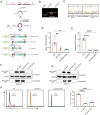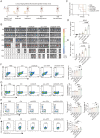Utilization of artificial circular RNAs as miRNA sponges and anti-PD-1 scFv expression platforms to suppress hepatocellular carcinoma progression
- PMID: 40568595
- PMCID: PMC12187678
- DOI: 10.3389/fimmu.2025.1609165
Utilization of artificial circular RNAs as miRNA sponges and anti-PD-1 scFv expression platforms to suppress hepatocellular carcinoma progression
Abstract
Background: Hepatocellular carcinoma (HCC) is characterized by a complex interplay of genetic and epigenetic alterations that contribute to its aggressive nature and resistance to conventional therapies. The recent advent of immune checkpoint inhibitors has shown promise in enhancing the immune system's ability to target cancer cells. However, the efficacy of these therapies is often hindered by the tumor's immunosuppressive microenvironment. Circular RNAs (circRNAs), a class of non-coding RNAs, have emerged as promising candidates for the development of novel therapeutics due to their unique properties, including resistance to degradation and the ability to act as miRNA sponges.
Methods: In this study, we engineered artificial circRNAs to target oncogenic miRNAs and to express anti-PD-1 scFv antibodies, aiming to simultaneously disrupt oncogenic pathways and enhance the immune response against HCC.
Results: Our results demonstrate that the engineered circRNAs effectively sponge miR-25, leading to subsequent inhibition of HCC cell proliferation and angiogenesis. Moreover, the expression of anti-PD-1 scFv antibodies from the circRNAs significantly enhanced the cytotoxic T-cell response against HCC cells. In vivo studies revealed a significant reduction in tumor volume and prolonged survival in mice treated with the engineered circRNAs compared to controls.
Conclusions: Our findings highlight the potential of artificial circRNAs as a novel therapeutic strategy for HCC. By harnessing their ability to act as miRNA sponges and to express immunomodulatory proteins, these engineered circRNAs offer a promising approach to overcome the challenges associated with HCC therapy.
Keywords: anti-PD-1; circular RNA; hepatocellular carcinoma; immunotherapy; miRNA sponge; scFv antibody.
Copyright © 2025 Lai, Wang, Cai, Li, Weng, Cai, Cai, Cheng, Zhao and Zeng.
Conflict of interest statement
The authors declare that the research was conducted in the absence of any commercial or financial relationships that could be construed as a potential conflict of interest.
Figures







Similar articles
-
Targeting USP47 enhances immunotherapy in hepatocellular carcinoma by destabilizing PD-L1.Int Immunopharmacol. 2025 Aug 28;161:115024. doi: 10.1016/j.intimp.2025.115024. Epub 2025 Jun 9. Int Immunopharmacol. 2025. PMID: 40494207
-
Matrix stiffness-dependent PD-L2 deficiency improves SMYD3/xCT-mediated ferroptosis and the efficacy of anti-PD-1 in HCC.J Adv Res. 2025 Jul;73:265-282. doi: 10.1016/j.jare.2024.08.021. Epub 2024 Aug 17. J Adv Res. 2025. PMID: 39159723 Free PMC article.
-
Tumor-suppressing multi-enterobacteria and PD-1/PD-L1 immune checkpoint inhibitor combination improves the outcome of hepatocellular carcinoma therapy.Front Immunol. 2025 Jun 20;16:1598436. doi: 10.3389/fimmu.2025.1598436. eCollection 2025. Front Immunol. 2025. PMID: 40621452 Free PMC article.
-
The role of the NcRNA/ferroptosis axis in lung cancer: molecular mechanisms and potential therapeutic targets.Apoptosis. 2025 Aug;30(7-8):1665-1694. doi: 10.1007/s10495-025-02127-8. Epub 2025 Jun 22. Apoptosis. 2025. PMID: 40544405 Review.
-
The Protective Role of miR-125b in Hepatocellular Carcinoma: Unraveling Tumor-Suppressive Mechanisms.Curr Mol Med. 2025;25(6):663-671. doi: 10.2174/0115665240304247240529074123. Curr Mol Med. 2025. PMID: 38859784 Review.
References
MeSH terms
Substances
LinkOut - more resources
Full Text Sources
Medical

